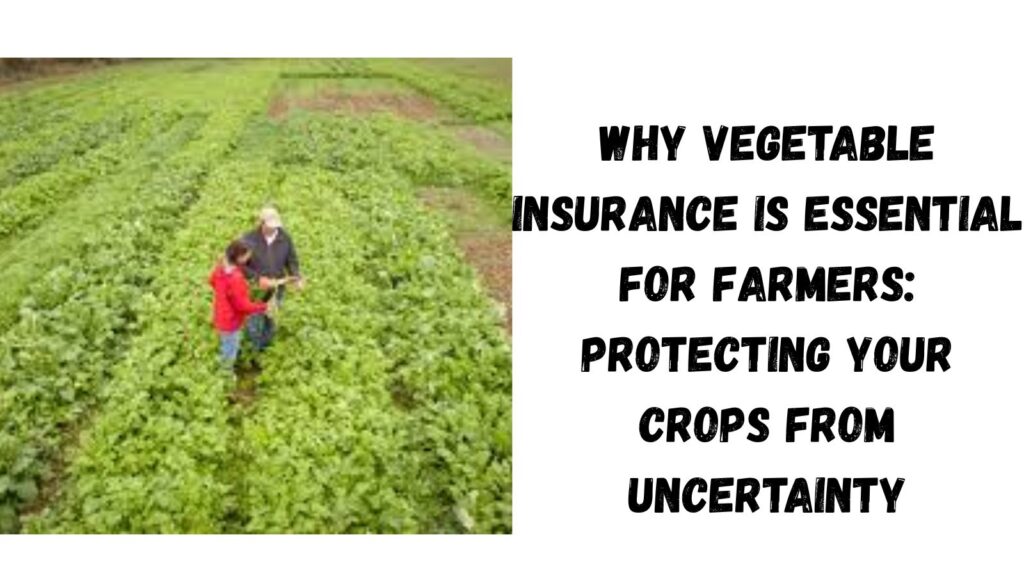Agriculture, especially vegetable farming, is a high-risk business. Farmers face many uncertainties. These include unpredictable weather, pests, diseases, and changing market prices. A single season of poor crop yield due to a natural disaster or market downturn can devastate a farmer’s livelihood. Vegetable insurance helps farmers by providing a safety net. It supports them during tough times, both in the weather and in their business.

In this article, we’ll look at why vegetable insurance matters for farmers. We’ll explain how it works, its benefits, and why every vegetable farmer should consider getting it. We’ll also look at real-world examples and answer common questions that farmers have about insurance.
What is Vegetable Insurance?
Contents
- 1 What is Vegetable Insurance?
- 2 The Importance of Vegetable Insurance for Farmers
- 3 Real-Time Examples of Vegetable Insurance Benefits
- 4 How Does Vegetable Insurance Work?
- 5 Benefits of Vegetable Insurance
- 6 Conclusion
- 7 FAQs
- 8 What types of crops can be insured under vegetable insurance?
- 9 How much does vegetable insurance cost?
- 10 Can vegetable insurance cover both yield loss and market price fluctuations?
- 11 Is vegetable insurance available worldwide?
- 12 How do I apply for vegetable insurance?
Vegetable insurance helps protect growers from financial losses. It covers risks like extreme weather, pest infestations, diseases, and changing market prices. It helps reduce the economic effects of sudden losses. This way, farmers can bounce back quickly and keep their operations running.
Crop insurance policies come from private insurers and government programs. They offer various coverage options based on the vegetable crop type, location, and specific risks.
The Importance of Vegetable Insurance for Farmers
- Protecting Against Unpredictable Weather: Vegetable crops can suffer from bad weather. Hailstorms, droughts, floods, and extreme temperatures can harm them. These events can decimate a year’s crop in a matter of days or even hours. For instance, in 2019, a drought in California led to over $3 billion in losses for farmers, affecting crops such as lettuce, tomatoes, and peppers. Vegetable insurance helps farmers by covering income loss from unexpected weather events. It is vital for keeping financial stability. This helps farmers operate in the next growing season.
- Covering Losses from Pest and Disease Infestations: Pest infestations and crop diseases can ruin vegetable yields. The U.S. tomato industry has faced serious losses due to bacterial wilt disease. This disease destroyed large areas of tomato crops in many states. Insect infestations, like the cabbage worm, can greatly lower the quality and yield of vegetables. Vegetable insurance helps farmers when pests damage their crops. They get money back to cover losses, so they can recover and avoid big financial problems.
- Mitigating Market Volatility: Vegetable prices can change quickly. This happens due to demand, supply chain issues, and global economic trends. The COVID-19 pandemic messed up supply chains and changed market prices. This put a lot of financial pressure on vegetable farmers worldwide. Vegetable insurance may include a revenue protection plan. This plan helps farmers handle price changes. It ensures they get paid if market prices drop below a set level.
- Reducing the Financial Risk for Farmers: Many vegetable farmers rely on loans to fund their operations. If they experience a crop failure, they may not be able to repay these loans, putting them at risk of losing their farms. Vegetable insurance provides financial security for farmers. It helps them pay loans and meet other financial needs. Fun Fact: In the U.S., over 40% of farmers use crop insurance. The Federal Crop Insurance Corporation (FCIC) says it pays out about $10 billion each year.
- Enhancing Farm Sustainability: Vegetable insurance protects against crop failure. This support helps farms stay sustainable for the long term. Farmers can reinvest in their farms. They can improve practices and adjust to changing conditions. This boosts farm resilience. It helps the whole agricultural industry and supports food security for communities.
Real-Time Examples of Vegetable Insurance Benefits
- The 2020 California Wildfires: In 2020, the wildfire season in California was one of the worst in history, burning over 4 million acres of land. Many vegetable farmers lost their crops to the flames. This was especially true for those growing lettuce, tomatoes, and carrots. Fortunately, those with vegetable insurance were able to recover their losses and continue farming in subsequent seasons.
- The 2015 European Cabbage Crisis: A late frost in 2015 caused a sudden cabbage shortage in Europe. This led to a price spike and big financial losses for unprepared farmers. Farmers with vegetable insurance received compensation for their losses. This help reduced their financial strain and let them get ready for the next growing season.
- Drought in India: In 2017, vegetable farmers in Maharashtra, Uttar Pradesh, and Tamil Nadu suffered greatly from a recurring drought. Crop insurance helped these farmers get compensation for lost crops like tomatoes, onions, and green chilies. This support allowed them to keep their operations going, even in tough conditions.
How Does Vegetable Insurance Work?
Vegetable insurance works by covering specific risks associated with vegetable farming. There are several types of policies available, including:
- Yield Protection: This policy covers the loss of crop yield due to extreme weather, disease, or pest infestations. The payout is typically based on the expected yield for the season and the actual yield after the loss event.
- Revenue Protection: This insurance helps farmers when they face yield loss or changes in market prices. It ensures that farmers receive compensation if the revenue from their crops falls below a certain level.
- Multi-Peril Crop Insurance (MPCI): MPCI policies cover various risks like drought, flood, hail, and disease. This is the most comprehensive type of vegetable insurance and is widely available for farmers in many regions.
Farmers typically need to assess their needs based on the specific crops they grow, the risks they face, and their budget. Vegetable insurance premiums change based on coverage level, crop type, and location.
Benefits of Vegetable Insurance
- Financial Stability and Peace of Mind: Insurance gives farmers confidence. It protects them from losing everything to an unexpected event. Knowing that they are protected allows them to focus on improving their farming techniques and crop management.
- Access to Emergency Funds: If a crop fails, insurance payouts give farmers emergency funds. These funds help them recover, pay off debts, and keep their operations going.
- Encouraging Investment: Insurance gives farmers a safety net. This makes them more likely to invest in new technologies and sustainable practices. As a result, their farming operations improve. Over time, this leads to better productivity and less risk.
Conclusion
In today’s world, farmers face many threats. Climate change, pests, diseases, and market changes can harm their livelihoods. That’s why vegetable insurance is crucial now more than ever. Vegetable insurance offers a safety net for unexpected risks. This support helps farms stay financially stable and thrive over time. Vegetable insurance supports farmers facing unpredictable weather, pest issues, and market changes. It provides the tools needed to succeed despite these challenges.
Farmers face new challenges every day. So, insurance is becoming more important to protect their livelihoods. Vegetable farmers can secure their future by investing in vegetable insurance. This choice brings peace of mind and protection against uncertainty.
How Climate Change is Reshaping Homeowners Insurance: Is Your Property Covered?
FAQs
What types of crops can be insured under vegetable insurance?
Vegetable insurance usually covers many types of crops. This includes tomatoes, lettuce, cucumbers, carrots, peppers, and onions. Policies are tailored to the specific crop and risk factors.
How much does vegetable insurance cost?
The cost of vegetable insurance varies by several factors. These include the type of crop, the level of coverage, and where the farm is located. On average, premiums range from 1-10% of the insured value of the crop.
Can vegetable insurance cover both yield loss and market price fluctuations?
Yes, some policies like revenue protection plans cover yield loss and price changes. This gives farmers complete protection.
Is vegetable insurance available worldwide?
Vegetable insurance is available in many countries, but coverage options and policies may vary. In countries like the U.S., India, and parts of Europe, vegetable insurance is commonly available.
How do I apply for vegetable insurance?
Farmers can apply for vegetable insurance through private insurance providers or government-backed programs. It’s essential to work with an insurance agent to choose the right coverage based on specific needs.
With the right insurance policy, vegetable farmers can protect their future. This helps lower financial risks and prepares them for upcoming challenges.


